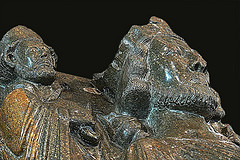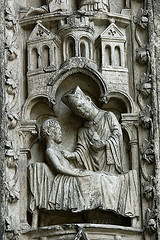Index of Gothic Sculpture
The Gothic period is characterized by the early simplicity of naturalistic figures to the late excessively enriched elegance and elaborate clothing of the figures in the later period, the subject matter of Gothic sculpture featured the mysticism of the mid to late medieval age with an emphasis on suffering and emotion.
 Designated a World heritage Site by UNESCO in 1979 the Cathedral of Notre-Dame de Chartres was built from between 1145 and 1250. It's high nave is spanned by ogival pointed arches to form the vault, and the walls are supported by double flying buttresses. Chartres is the first building to have used buttresses as a structural element.
Designated a World heritage Site by UNESCO in 1979 the Cathedral of Notre-Dame de Chartres was built from between 1145 and 1250. It's high nave is spanned by ogival pointed arches to form the vault, and the walls are supported by double flying buttresses. Chartres is the first building to have used buttresses as a structural element.
Chartres Cathedral is also unique in having retained almost all of its original 12th and 13th century stained glass.
 The portal of St Anne on the right of the western façade was built in 1200 and is the earliest of the three portals to be built. The tympanum is actually dated to about 1150 and was once part of the earlier cathedral of St. Stephen whose western façade was once 40 metres to the west of the present Cathedral.
The portal of St Anne on the right of the western façade was built in 1200 and is the earliest of the three portals to be built. The tympanum is actually dated to about 1150 and was once part of the earlier cathedral of St. Stephen whose western façade was once 40 metres to the west of the present Cathedral.
The western façade of the cathedral of Notre-Dame in Paris, with its twin towers, was built between 1200 and 1240. With its three portals containing scenes from the life of the Virgin Mary, the Last Judgment, and scenes from the life of St. Anne, it is considered one of the finest examples of early Gothic architecture.
 This portal of the Virgin, at Notre Dame Paris, was sculpted between 1210 and 1220. The main scene show the Coronation of the Virgin, where Mary is being crowned Queen of heaven by an angel, whilst she sits on the same throne as Jesus. In the lintel below is Mary on her death bed surrounded by Jesus and the twelve aposles, two angels are about to lift her to heaven. In the lower lintel the old testament prophets are holding scrolls prophesying Christ.
This portal of the Virgin, at Notre Dame Paris, was sculpted between 1210 and 1220. The main scene show the Coronation of the Virgin, where Mary is being crowned Queen of heaven by an angel, whilst she sits on the same throne as Jesus. In the lintel below is Mary on her death bed surrounded by Jesus and the twelve aposles, two angels are about to lift her to heaven. In the lower lintel the old testament prophets are holding scrolls prophesying Christ.
 Tomb of King John the youngest son of Henry II and Eleanor of Aquitaine. Made from Purbeck marble the sarcophagus dates from about 1230 and is the earliest effigy in the country to an English king. Originally the effigy would have lain on the floor, but as more elaborate tombs were installed in later years, John's effigy was raised up to rest on a tomb chest that was made in about 1540.
Tomb of King John the youngest son of Henry II and Eleanor of Aquitaine. Made from Purbeck marble the sarcophagus dates from about 1230 and is the earliest effigy in the country to an English king. Originally the effigy would have lain on the floor, but as more elaborate tombs were installed in later years, John's effigy was raised up to rest on a tomb chest that was made in about 1540.





